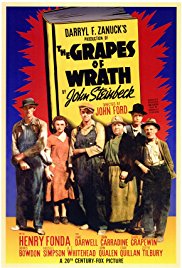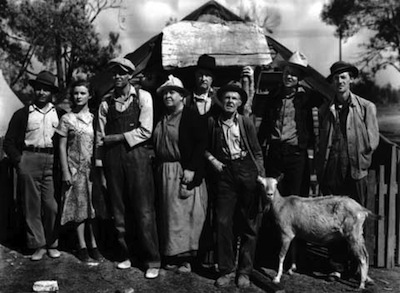During the 1920s and 1930s, farmers plowed up grassland on the Southern Great Plains to plant wheat. In 1934 and 1935, in parts of Texas, Oklahoma, Kansas, Nebraska, Colorado and the Dakotas, a severe drought killed the wheat plants. High winds blew the topsoil off the land and into huge dunes. Violent dust storms turned the sky black at midday and people had to breathe through handkerchiefs to keep from choking on the dust. About 150,000 square miles of land in the Southern Great Plains came to be called the Dust Bowl.
Because of these conditions, farmers were unable to make their mortgage payments and the banks took the land. Many small farms were consolidated into large holdings owned by corporations and farmed by employees. Hundreds of thousands of once independent and self-sufficient farmers were run off their land. Many emigrated west to California where they became migrant farm workers taking low paid temporary jobs. They were called “Oakies” since many came from Oklahoma, one of the states hardest hit by the drought and soil erosion. They lived in their cars or in camps, usually in miserable conditions. They worked when they could but since the California farmers needed them only at certain times of the year, such as harvest time, they spent many months without work.
When people lose their jobs and homes, families come under stress. Some break up, others get stronger, but adversity changes most families. Some family members will die earlier than they would normally, others will leave home, and some may get into trouble with the law. The relative positions of the various people in the family may also change. The father of the Joad family had been the head of the household on the farm in Oklahoma. By the time the family reached California, he admitted that he didn’t feel useful any more and that he kept thinking of the way it was before the family was forced off their land. By the end of the story, the mother is the strongest member of the family. It is she to whom Tom says goodbye when he leaves. The character of the mother acknowledges this by saying, “A woman can change better than a man.”
The “Reds” referred to in the film are the Communists. The movie shows how at times Red Scare tactics were used to prejudice people against Americans who protested oppressive conditions or tried to form labor unions. For other films in which Red Scare tactics play a role, see Matewan, Native Son, Fat Man, and Little Boy and, by analogy, The Crucible and High Noon.
John Steinbeck (1902 – 1968) received the Pulitzer Prize for the novel The Grapes of Wrath. He was awarded the Nobel Prize for Literature in 1962. Some of his other works are: Cannery Row, Tortilla Flat, and Of Mice and Men. These books are appropriate for 14 and 15-year-olds.
Franklin Roosevelt’s First Inaugural Address delivered in 1933, in the depths of the Great Depression, is referred to in the film. His most famous sentence is that: “the only thing we have to fear is fear itself–nameless, unreasoning, unjustified terror”. However, there is more to this speech which speaks directly to us today. Those portions are set out below.
… This is preeminently the time to speak the truth, the whole truth, frankly and boldly. Nor need we shrink from honestly facing conditions in our country today. This great Nation will endure as it has endured, will revive and will prosper. So, first of all, let me assert my firm belief that the only thing we have to fear is fear itself — nameless, unreasoning, unjustified terror which paralyzes needed efforts to convert retreat into advance. In every dark hour of our national life a leadership of frankness and vigor has met with that understanding and support of the people themselves which is essential to victory. I am convinced that you will again give that support to leadership in these critical days.
In such a spirit on my part and on yours we face our common difficulties. They concern, thank God, only material things. Values have shrunken to fantastic levels; taxes have risen; our ability to pay has fallen; government of all kinds is faced by serious curtailment of income; the means of exchange are frozen in the currents of trade; the withered leaves of industrial enterprise lie on every side; farmers find no markets for their produce; the savings of many years in thousands of families are gone.
More important, a host of unemployed citizens face the grim problem of existence, and an equally great number toil with little return. Only a foolish optimist can deny the dark realities of the moment.
Yet our distress comes from no failure of substance. We are stricken by no plague of locusts. Compared with the perils which our forefathers conquered because they believed and were not afraid, we have still much to be thankful for. Nature still offers her bounty and human efforts have multiplied it. Plenty is at our doorstep, but a generous use of it languishes in the very sight of the supply. Primarily this is because the rulers of the exchange of mankind’s goods have failed, through their own stubbornness and their own incompetence, have admitted their failure, and abdicated. Practices of the unscrupulous money changers stand indicted in the court of public opinion, rejected by the hearts and minds of men.
True they have tried, but their efforts have been cast in the pattern of an outworn tradition. Faced by failure of credit they have proposed only the lending of more money. Stripped of the lure of profit by which to induce our people to follow their false leadership, they have resorted to exhortations, pleading tearfully for restored confidence. They know only the rules of a generation of self-seekers. They have no vision, and when there is no vision the people perish.
The money changers have fled from their high seats in the temple of our civilization. We may now restore that temple to the ancient truths. The measure of the restoration lies in the extent to which we apply social values more noble than mere monetary profit.
Happiness lies not in the mere possession of money; it lies in the joy of achievement, in the thrill of creative effort. The joy and moral stimulation of work no longer must be forgotten in the mad chase of evanescent profits. These dark days will be worth all they cost us if they teach us that our true destiny is not to be ministered unto but to minister to ourselves and to our fellow men.
Recognition of the falsity of material wealth as the standard of success goes hand in hand with the abandonment of the false belief that public office and high political position are to be valued only by the standards of pride of place and personal profit; and there must be an end to a conduct in banking and in business which too often has given to a sacred trust the likeness of callous and selfish wrongdoing. Small wonder that confidence languishes, for it thrives only on honesty, on honor, on the sacredness of obligations, on faithful protection, on unselfish performance; without them it cannot live.



